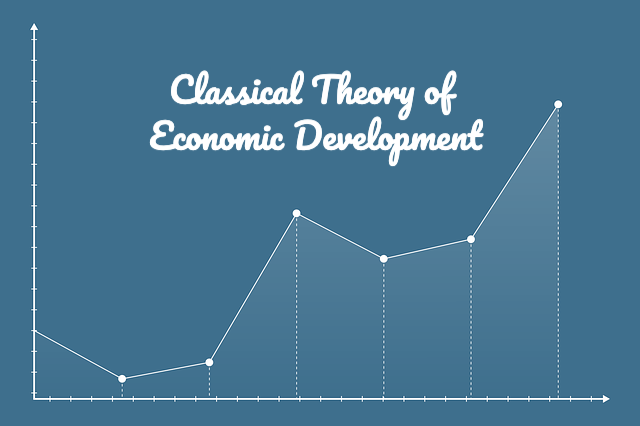Classical Theory of Economic Development
The period from 1776 to 1890 is known as the Classical Era in the history of economics. This era is considered to have begun after the publication of the book "Wealth of Nations" by Adam Smith, who is regarded as the founder of economics.
Just as Adam Smith considered wealth to be the primary element for economic development, other economists of this era, such as David Ricardo, Thomas Robert Malthus, J.B. Say, and John Stuart Mill, also emphasized wealth. All these economists are known as Classical Economists.
The Classical Theory of Economic Development is considered to have evolved by incorporating the economic development issues raised by these economists.
This theory includes the following subjects:
1. Laissez-faire Policy
Classical economists presented various concepts regarding economic development. One of the major concepts among them is that the government should not directly interfere in economic activities. For economic development to occur in any economy, a free market without government intervention, full competition in goods and services, and an automatic economy are necessary.
In their view, the private sector should be allowed to operate in profitable investment opportunities, and the government should invest in activities that provide direct and indirect services to citizens, such as policy making, maintaining peace and security, building roads and bridges, opening schools, and building hospitals.
They also believed that the private sector should be left free to decide what to produce, how to produce, how much to produce, and for whom to produce, based on their own resources.
2. Capital Accumulation
For the economic development of any economy, capital investment in industries is indispensable. Industries can produce daily consumer goods such as clothes, utensils, and food, as well as productive goods such as machinery, equipment, and tools.
Capital accumulation is considered a prerequisite for the necessary investment in industries to produce both types of goods. Individuals and organized institutions save a portion of their income in banks and financial institutions. These savings are then provided as loans by banks to productive industries. Industries invest the received funds in machinery, equipment, tools, and technology.
This investment leads to an increase in production, resulting in increased income and savings for producers, workers, and savers, ultimately contributing to economic prosperity and economic development through industrial development.
3. Profit as an Incentive for Investment
According to the Classical Theory of Economic Development, profit is considered the main driving force for investment. The higher the profit in any business, the greater the investment. Higher investment leads to even higher profits and increased savings.
The saved amount is reinvested, leading to an increase in employment and economic development.
Therefore, classical economists argued that profits should be taxed less, as profit is a determinant of increased investment.
4. Stationary State
In a capitalist economy, economic development gradually increases but reaches a stationary state after a certain period. The potential for profit generation diminishes. Unhealthy competition begins among investors. Natural resources are depleted. Investment opportunities gradually decrease. Employment opportunities decline.
The wage rate of workers starts to decrease. Agriculture is subject to the principle of diminishing returns. Thus, classical economists presented the concept that an economy can reach a stationary state.
5. Demise of Capitalism
The Classical Theory of Economic Development presents the concept that the process of capitalist economic development will be obstructed one day. Unhealthy competition among capitalists can lead to an increase in workers' wages, an increase in the price of raw materials, and consequently, a decrease in profits.
The law of diminishing returns applies to agriculture, leading to price increases and reduced profits as demand exceeds food supply. As a result, the ultimate outcome of economic development is economic stagnation and the demise of capitalism.
Criticisms of Classical Theory of Economic Development
The classical theory of economic development was criticized in many ways by different economists. Some of the main criticisms are as follows:
-
Excessive Dependence on Free Markets
The classical theory assumes that only free-market forces can drive economic growth. However, government intervention in infrastructure, education, and healthcare is also necessary for long-term development. -
Neglect of Technological Innovation
Classical economists mainly focused on labor and capital as factors of production but they did not emphasize the role of technological advancements to increase productivity and economic growth. -
Rigid Wage and Unrealistic Population Assumptions
According to classical theory, wages remain at subsistence levels due to population growth. However, education, skill development, and labor market regulations can enable workers to earn higher wages over time. -
Failure to Address Income Inequality
The theory assumes that economic growth benefits all individuals in an equal manner. However, income inequality has persisted in many economies despite of economic growth. -
Static View of Development
The classical theory presents economic development as a mechanical process but it does not consider external factors like globalization, financial markets, and technological disruptions which also influence modern economies.






.jpeg)


 The Economic Frontline is a knowledge-driven platform offering thoughtful economic perspectives, policy-focused, and analytical content on national and global financial trends.
The Economic Frontline is a knowledge-driven platform offering thoughtful economic perspectives, policy-focused, and analytical content on national and global financial trends.
